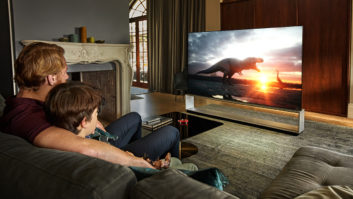The networking revolution is about to enter a new phase within the Internet Age. If you thought this business wave had washed on past while you were still picking out your surf board, you’d better get your suit on and hit the beach running.
A new genre of products, which are more meaningful and actually tested prior to release, are about to hit the market. As a result, the residential systems installation industry needs to take note, engage in education and be prepared to address this market with a vengeance.
People continue to want on-demand information, entertainment and convenient home control. It’s crucial to identify the opportunity and establish why it’s an opportunity. Only then can the custom installation industry understand what steps it should take.
Client desires can best be categorized as business, personal, entertainment and home automation. Combined they become a lifestyle, all from the same home network. It’s the combination of the three that adds value and justifies, many times over, the installation of a home network. Selling the network then becomes a solutions-oriented prospect.
From a business-user standpoint the primary driver for making this investment is the added ability to access the Internet whenever they want. Applications can range from a simple remote telecommuting capabilities package, including e-mail or voicemail, to the comprehensive concept of SOHO (Small Office Home Office).
From a personal standpoint, the home network serves as a means of communicating with friends and colleagues, fast research, shopping, all of which are lifestyle related. Beyond business and personal convenience, there’s the ability to extend that network into the actual control aspects of a home–to use an existing PC as an interface to control audio systems, video systems, temperature systems, security system, etc.
Home automation and system control, entertainment and other personal communication, combined with productive business functionality, add up to the data-driven lifestyle home networks provide and people continue to want.
The goal, therefore, for residential systems professionals dealing with the rebirth of the Internet age is to empower and engage people to be enthusiastic about spending money on these ideas. The opportunity for the industry is to provide more than a home network, but home networking solutions that empower and engage people.
Communicating the solution is the opportunity and leadership challenge available to custom installation professionals as the Internet age reaches its second phase. Of the potential solutions, the most compelling is home system control.
Residential systems professionals must create a life-long technology strategy for their customer. Creating this plan is really a function of designer/installers establishing what parts, pieces and infrastructure need to be laid down or need to be decided upon to fill current and future needs. For example, 10 megabits over your customer’s home network seemed to be fine for a while, until someone created 100 megabit over the same network. Now gigabit and beyond can be achieved through copper or fiber. If you think about Internet connection speed being somewhere between 56 kilobit all the way up to the 3-6 megabit bursts on a cable modem, a simple 10-base T network actually has many times the bandwidth than the content coming in. Do your own math as the application and people’s hunger for information derive what the bandwidth requirements are.
There will soon be a time when storing terabits of information and streaming it will be a reality, making fiber the answer. In contrast with the idea that fiber has no use currently, many installers already use fiber successfully on projects where there are multiple buildings to connect, as fiber is also impervious to lightening and interference and data transmission on it involves no latency.
In an increasing number of new neighborhoods, local cable and phone companies have laid fiber rings around cities and brought it into subdivisions, although the fiber is not lit yet. If you have fiber at the curb, then you will have access at the highest performance level of the content you are receiving.
With a very simple home network, technology is seamlessly integrated into a homeowner’s lifestyle. Dealers can actualize the financial opportunity by merely demystifying the network which empowers the user. CEDIA’s leadership is simply recognizing people don’t want to buy technology, but rather buy solutions.
Solutions lie in leveraging Internet connectivity, the home network and a PC (or touch panel) to immerse the homeowner in additional entertainment, productivity capabilities and control of their house. The incremental value of installing a surround sound system in a room may only feel worthwhile if a homeowner watches a lot of movies. Looking at the entertainment aspects of extending the network, key features are immersion, flexibility and choice. Beyond downloading MP3 and video files, a network allows the homeowner to listen to any source in any given area of the house.
More specifically, a sports fan can listen to an audio broadcast and distribute it around the house and into the garage. For a more immersed experience, the television can provide the background visual, while they’re participating in the poll on foxsports.com and while listening to their preferred national football broadcast over their speakers. You can literally be immersed in three experiences concurrently. For the homeowner, it’s a way to have it their way.
The addition of a network addresses more than just entertainment, however. It also enables control of audio all over the house, climate throughout the house, handles security, automates lighting changes, or even keeps an eye on the children in another part of the house.
With a network and a broadband connection, a personalized newspaper can automatically update itself. Different household members can customize their pages to automatically update them on their interests: weather, traffic, up to the minute stock prices, seeing how your own personal portfolio performed, sports scores, world events to be considered that day, your flight schedule, the latest on personal interests, horoscopes, even homework assignments or any other meaningful information.
Dealers who also spec security systems, might could look beyond the “children in another room” capability of a network and enable vacation home monitoring as well. There’s value in that sort of peace of mind for a client and home networks can make this cost-effective.
For many residential systems professionals, installing a home network is a productivity tool. If for no other reason than cost savings on service calls, dealers have found it to be more efficient communicating to the home network via the Internet to execute remote diagnostics. Not having to dispatch a service person to make periodic changes is a tremendous cost savings.
Combining a consumer’s increasing thirst for information and control of their home, with a dealer’s desire to become more productive, should offer a very compelling reason to look into this market. Has the networking revolution passed you by? Absolutely not. The question is, “Have you ever identified what a home network’s actual potential really is?” Understanding the solutions a home network can provide makes it a easy for residential systems designers and installers to realize the extremely large business opportunity whose future is really just beginning.
Bob Kransen is the co-founder of Axiom Design Inc. in Pleasanton, California.







